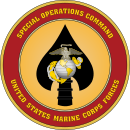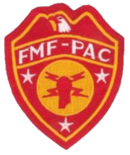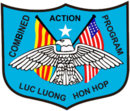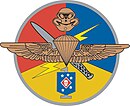
A Marine Expeditionary Unit is the smallest air-ground task force (MAGTF) in the United States Fleet Marine Force. Each MEU is an expeditionary rapid reaction force ready to answer any crisis, whether it be disaster aid or a combat mission. Marine Amphibious Unit (MAU) was the name used until the late 1980s.

Force Reconnaissance (FORECON) are United States Marine Corps reconnaissance units that provide amphibious reconnaissance, deep ground reconnaissance, surveillance, battle-space shaping and limited scale raids in support of a Marine Expeditionary Force (MEF), other Marine air-ground task forces or a joint force. As conventional forces, during large-scale operations, Force Reconnaissance companies report to the Marine Expeditionary Force (MEF) and provide direct action and deep reconnaissance. Though commonly misunderstood to refer to reconnaissance-in-force, the name "Force" Recon refers to the unit's relationship with the Marine Expeditionary Force or Marine Air-Ground Task Force. Force reconnaissance platoons formed the core composition of the initial creation of the Marine Special Operations Teams (MSOTs) found in Marine Forces Special Operations Command (MARSOC) Raider battalions, though Marine Raiders now have their own separate and direct training pipeline.

The United States Marine Corps Reconnaissance Battalions are the special operations capable forces assets of Marine air–ground task force (MAGTF) that provide division-level amphibious reconnaissance, counter reconnaissance, direct action, ground reconnaissance, irregular warfare, long-range penetration, maneuver warfare, and special reconnaissance to the Ground Combat Element within the United States Marine Corps (USMC). Division reconnaissance teams are employed to observe and report on enemy activity and other information of military significance in close operations. The Military Occupational Specialty code for Reconnaissance Marine is 0321.
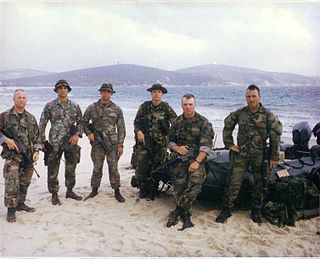
The Radio Reconnaissance Platoon is a specially trained Marine Corps Intelligence element of a United States Marine Corps Radio Battalion. A Radio Reconnaissance Team (RRT) was assigned as the tactical signals intelligence collection element for the Marine Corps Special Operations Command, Detachment One. Regular RRTs also participate in SOC operations during Marine Expeditionary Unit, or MEU(SOC), deployments.
In the United States Marine Corps, a Marine air–ground task force is the principal organization for all missions across the range of military operations. MAGTFs are a balanced air–ground, combined arms task organization of Marine Corps forces under a single commander that is structured to accomplish a specific mission. The MAGTF was formalized by the publishing of Marine Corps Order 3120.3 in December 1963, "The Marine Corps in the National Defense, MCDP 1-0". It stated:
A Marine air–ground task force with separate air ground headquarters is normally formed for combat operations and training exercises in which substantial combat forces of both Marine aviation and Marine ground units are included in the task organization of participating Marine forces.

The 1st Reconnaissance Battalion is a reconnaissance battalion in the United States Marine Corps. It is a stand-alone battalion with no parent regiment. Instead, it falls directly under the command of the 1st Marine Division. 1st Recon Bn is located at Marine Corps Base Camp Pendleton in San Diego, California.
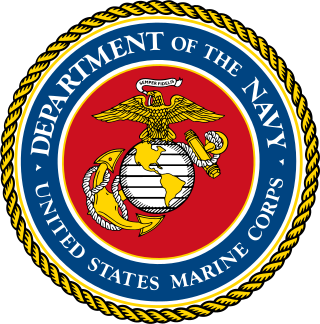
The United States Marine Corps is organized within the Department of the Navy, which is led by the Secretary of the Navy (SECNAV). The most senior Marine commissioned officer is the Commandant of the Marine Corps, responsible for organizing, recruiting, training, and equipping the Marine Corps so that it is ready for operation under the command of the unified combatant commanders. The Marine Corps is organized into four principal subdivisions: Headquarters Marine Corps, the Operating Forces, the Supporting Establishment, and the Marine Forces Reserve.
The Observer Group was a joint-United States Army/Marine Corps unit that was the first in the United States and Fleet Marine Force to be organized and trained specifically for amphibious reconnaissance. The Observer Group experimented in the methodology and equipment for projecting reconnaissance from the sea before the establishment of the OSS Maritime Unit, the Underwater Demolition Teams, and before the Army Special Forces and Air Commandos. It was also the birth of naval amphibious intelligence.

A Special Amphibious Reconnaissance Corpsman (SARC) is a United States Navy hospital corpsman who provides MARSOC and other USSOCOM units advanced trauma management associated with combatant diving and parachute entry. Traditionally, they are attached to the Marine Corps Force Reconnaissance companies to help support the Command Element of the Marine Air-Ground Task Force in special reconnaissance missions.

A Maritime Special Purpose Force (MSPF) is a United States Marine Corps specialized sub-unit of a Marine expeditionary unit. A MSPF is deployed to give the commanders low profile, two-platoon surgical emplacement in the accessible littoral regions. The MSPF provides the enhanced operational capability and precision skills to complement, enable, and execute selected conventional, maritime special operations. They can also perform operations not resident in traditional amphibious raid companies.
The reconnaissance mission within the United States Marine Corps is divided into two distinct but complementary aspects; Marine Division Recon and Force Reconnaissance.
The United States Marine Corps Scout and Sniper companies and the Scouts (Tank) companies of the tank battalions were the first among the division's reconnaissance assets. They existed around the same exact moment when 1st and 2nd Marine Division were created. In 1941, each regiment had a scout and sniper platoon. They were assigned to the regimental Headquarters and Service Company. These companies were used in variety of tasks and, on occasion in severe combat, were used as "spare" rifle companies. When 6th Marine Division deactivated after the end of World War II, its recon assets also deactivated. Only the current Marine Division Recon Battalions that exist today hold history reference to the Scout and Sniper Companies.

1st Force Reconnaissance Company conducted deep reconnaissance and direct action raids in support of I Marine Expeditionary Force requirements across the range of military operations to include crisis response, expeditionary operations and major combat operations. 1st Force Recon Company was deactivated on 26 October 2006 and the majority of the personnel were used to establish the 1st Marine Special Operations Battalion.
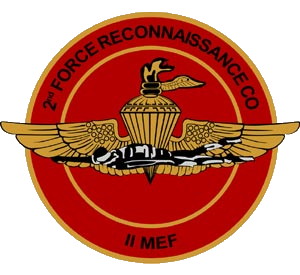
The Second Force Reconnaissance Company was the deep reconnaissance/direct action that was assigned to the Fleet Marine Force, Atlantic and its subordinate elements of the Marine Air-Ground Task Force.

The Reconnaissance Battalion or RECON is an elite recon battalion in the Royal Thai Marine Corps (RTMC), falling under the Royal Thai Marine Division. A special operations forces unit, it is capable of conducting land, maritime, and air operations.


